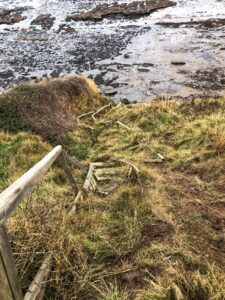On the Cleveland Way, below Hummersea Farm, a Public Footpath descends toward what was, as a Victorian postcard once called it, a “beach.” The path has been generously cleared of bracken and other wild vegetation, and a few strategically placed trail markers beckoned me downward. Naturally, I followed. But halfway down, at a shiny new bench—a sure sign of human intervention—the effort to maintain the path stopped cold, as if the National Park had simply lost interest.

The last time I tackled this steep descent, some four years ago, the wooden steps and walkways were still hanging on. But even then, the final stretch of metal steps swayed alarmingly, as though testing my nerve. Now, the years have not been kind. The wooden steps have rotted into a state of near-nonexistence, and the metal staircase stands rusted, tilted, and clinging vertically to the cliff. Enterprising locals, bless their hearts, have provided an aluminum ladder as a makeshift bypass, a solution both practical and faintly ominous.
Focused on keeping myself upright, I couldn’t spare much attention for the remains of the old alum house as I stumbled my way downward. But once I reached the beach, I turned back to take in the scene: a single arch, crumbling and solitary, stubbornly defying the elements. According to an information board further up the Cleveland Way, this ruin belonged to a three-story alum house, part of a once-bustling industrial site. Others argue it might have been a kiln for cementstone or for kelp-burning—take your pick. Either way, the arch didn’t quite align with old photos of the alum house, though I’m no expert on crumbling ruins. The East Cleveland Image Archives has some excellent old photographs.
Once, this was the beating heart of Hummersea’s alum trade. Up to 150 years ago, a tall factory and a cluster of cottages stood at the base of these cliffs, known as Hummersea Banks. But the ever-hungry North Sea has been devouring them bit by bit. Now, all that remains is this forlorn skeleton of a structure, likely to meet its watery fate in the next spring tide.
Hummersea’s alum trade thrived in the 17th and 18th centuries, hitting a peak in the early 19th before declining precipitously in 1831, when cheaper methods of production rendered it obsolete. By the 1860s, the quarrying and processing had ceased entirely, leaving behind an industrial graveyard on the edge of the cliffs.
These quarries were once busy extracting shale to manufacture alum—a chemical essential for fixing dye in textiles. Today, though, this part of the Yorkshire Coast is better known for its Jurassic geology, a treasure trove of fossils from a time when this region was a tropical sea floor. Marine reptiles like plesiosaurs and ichthyosaurs once roamed those waters, leaving their remains alongside ammonites and other prehistoric creatures.
Now, the cliffs tell a dual story: ancient seas teeming with life and modern industry reduced to ruin. Hummersea stands as a reminder that even the most prosperous ventures, much like the cliffs themselves, eventually crumble into the sea.

Leave a Reply to Len Small Cancel reply